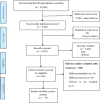The proportion of loss to follow-up from antiretroviral therapy (ART) and its association with age among adolescents living with HIV in sub-Saharan Africa: A systematic review and meta-analysis
- PMID: 35951621
- PMCID: PMC9371308
- DOI: 10.1371/journal.pone.0272906
The proportion of loss to follow-up from antiretroviral therapy (ART) and its association with age among adolescents living with HIV in sub-Saharan Africa: A systematic review and meta-analysis
Abstract
Background: Human immunodeficiency virus (HIV) remains a global health threat, especially in developing countries. The successful scale-up of antiretroviral therapy (ART) programs to address this threat is hindered by a high proportion of patient loss to follow-up (LTFU). LTFU is associated with poor viral suppression and increased mortality. It is particularly acute among adolescents, who face unique adherence challenges. Although LTFU is a critical obstacle on the continuum of care for adolescents, few regional-level studies report the proportion of LTFU among adolescents receiving ART. Therefore, a systematic review and meta-analysis were conducted to estimate the pooled LTFU in ART programs among adolescents living with HIV in sub-Saharan Africa (SSA).
Methods: We searched five databases (PubMed, Embase (Elsevier), PsycINFO, CINAHL, and Scopus) for articles published between 2005 and 2020 and reference lists of included articles. The PRISMA guidelines for systematic reviews were followed. A standardised checklist to extract data was used. Descriptive summaries were presented using narrative tables and figures. Heterogeneity within the included studies was examined using the Cochrane Q test statistics and I2 test. Random effect models were used to estimate the pooled prevalence of LTFU among ALHIV. We used Stata version 16 statistical software for our analysis.
Results: Twenty-nine eligible studies (n = 285,564) were included. An estimated 15.07% (95% CI: 11.07, 19.07) of ALHIV were LTFU. Older adolescents (15-19 years old) were 43% (AOR = 0.57, 95% CI: 0.37, 0.87) more likely to be LTFU than younger (10-14 years old) adolescents. We find an insignificant relationship between gender and LTFU (AOR = 0.95, 95% CI: 0.87, 1.03). A subgroup analysis found that regional differences in the proportion of adolescent LTFU were not statistically significant. The trend analysis indicates an increasing proportion of adolescent LTFU over time.
Conclusions and recommendations: The proportion of LTFU among HIV-positive adolescents in SSA seems higher than those reported in other regions. Older adolescents in the region are at an increased risk for LTFU than younger adolescents. These findings may help policymakers develop appropriate strategies to retain ALHIV in ART services. Such strategies could include community ART distribution points, appointment spacing, adherence clubs, continuous free access to ART, and community-based adherence support.
Conflict of interest statement
The authors have declared that no competing interests exist.
Figures









Similar articles
-
The association between HIV diagnosis disclosure and adherence to anti-retroviral therapy among adolescents living with HIV in Sub-Saharan Africa: A systematic review and meta-analysis.PLoS One. 2023 May 11;18(5):e0285571. doi: 10.1371/journal.pone.0285571. eCollection 2023. PLoS One. 2023. PMID: 37167342 Free PMC article.
-
The association between diagnosis disclosure and adherence to antiretroviral therapy among adolescents living with HIV in sub-Saharan Africa: a protocol for systematic review and meta-analysis.Syst Rev. 2020 Jul 14;9(1):160. doi: 10.1186/s13643-020-01420-8. Syst Rev. 2020. PMID: 32665026 Free PMC article.
-
Barriers to anti-retroviral therapy adherence among adolescents aged 10 to 19 years living with HIV in sub-Saharan Africa: A mixed-methods systematic review protocol.PLoS One. 2022 Sep 30;17(9):e0273435. doi: 10.1371/journal.pone.0273435. eCollection 2022. PLoS One. 2022. PMID: 36178934 Free PMC article.
-
Contemporary issues on the epidemiology and antiretroviral adherence of HIV-infected adolescents in sub-Saharan Africa: a narrative review.J Int AIDS Soc. 2015 Sep 16;18(1):20049. doi: 10.7448/IAS.18.1.20049. eCollection 2015. J Int AIDS Soc. 2015. PMID: 26385853 Free PMC article. Review.
-
Incidence and predictors of loss to follow-up among Ethiopian children on antiretroviral therapy: a systematic review and meta-analysis.BMC Public Health. 2024 Jan 13;24(1):169. doi: 10.1186/s12889-023-17333-9. BMC Public Health. 2024. PMID: 38218779 Free PMC article.
Cited by
-
Characterizing the HIV care continuum among children and adolescents with HIV in eastern and southern Africa in the era of "Universal Test and Treat": A systematic review and meta-analysis.J Int AIDS Soc. 2025 Jun;28(6):e26526. doi: 10.1002/jia2.26526. J Int AIDS Soc. 2025. PMID: 40515449 Free PMC article. Review.
-
Incidence and predictors of mortality among adolescents on antiretroviral therapy in Amhara Region, Ethiopia: a retrospective cohort analysis.BMJ Open. 2022 Nov 9;12(11):e063879. doi: 10.1136/bmjopen-2022-063879. BMJ Open. 2022. PMID: 36351711 Free PMC article.
-
Retrospective cohort study of predictors of loss to follow up among adolescents and young adults living with HIV on ART in Dar es Salaam, Tanzania, 2015-2019.BMC Infect Dis. 2025 Jul 1;25(1):852. doi: 10.1186/s12879-025-11157-1. BMC Infect Dis. 2025. PMID: 40597756 Free PMC article.
-
Time-dependent predictors of loss to follow-up in HIV care in low-resource settings: A competing risks approach.PLoS One. 2025 Jul 24;20(7):e0329132. doi: 10.1371/journal.pone.0329132. eCollection 2025. PLoS One. 2025. PMID: 40705795 Free PMC article.
-
A multilevel health system intervention for virological suppression in adolescents and young adults living with HIV in rural Kenya and Uganda (SEARCH-Youth): a cluster randomised trial.Lancet HIV. 2023 Aug;10(8):e518-e527. doi: 10.1016/S2352-3018(23)00118-2. Lancet HIV. 2023. PMID: 37541706 Free PMC article. Clinical Trial.
References
-
- HIV/AIDS JUNPo: Global Report: UNAIDS report on the global AIDS epidemic 2013. Geneva: UNAIDS; 2013. Google Scholar 2017.
Publication types
MeSH terms
Substances
LinkOut - more resources
Full Text Sources
Medical
Research Materials

